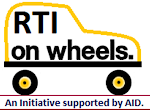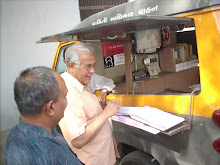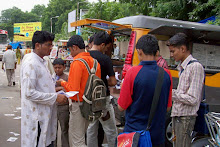IDR: Article: Saturday, 18th October 2025.
People's ability to use the RTI Act is often shaped by how state portals are designed, which can pose challenges including inaccessibility and incomplete information. Here are some tips for filing RTIs and the broad changes that are needed.
October 2025 marks 20 years since the implementation of the Right to Information (RTI) Act, 2005. A landmark piece of legislation that was the result of a grassroots movement for transparency and accountability, the act gives every Indian citizen the right to access information held by public authorities. The scope of information that can be sought is broad, with only limited exemptions for matters including those related to national security, sovereignty, and trade secrets.
While filing an RTI request has become fairly streamlined, especially with the option of online applications, there are significant differences in the state-level portals. Over the course of filing RTIs across the country, I found variations in application fees, requirements to submit identification documents such as Aadhaar, and printing and appeals charges, among others. Such provisions often pose a challenge to accessing information under the act.
Based on my experience of using these different state portals, I have identified certain features that make the application process easier, the gaps in the RTI process, and some ways of filing requests to get more accurate responses.
Variations in state-level portals for filing RTIs
State-level RTI portals vary in their user-friendliness. Out of the 12 states where I filed RTIs, some had implemented features that made filing and tracking applications simpler.
These differences
highlight that while the RTI Act provides a uniform framework, the actual
citizen experience of exercising this right is shaped by how each state
designs, manages, and uses its portal. Where details are not readily available
or systems are difficult to use, access to information becomes restricted.
Challenges in the RTI process
1. Information opacity
It is often unclear which authority holds the information being sought, leading to frequent transfers of requests between departments. Moreover, despite requesting information that should have been readily available within state management information systems, responses often take time. In several instances, my applications were transferred to other departments before I received a reply.
Although the act requires such transfers to be completed within five days, in practice they are sometimes made much later often veering close to the 30-day response deadline. This creates uncertainty about when the clock resets and whether it is the right time to file an appeal.
2. Additional charges and lack of online payment systems
When the requested information is lengthy, authorities commonly seek additional payment (typically INR 2 per page for printouts). While this is permitted under the act, most state portals, except Rajasthan’s, do not support online payments for additional charges. Many states still insist on demand drafts or postal payment orders.
Since the statutory 30-day response period pauses until payment is received, the lack of official payment acknowledgement leaves citizens unsure about when the countdown for appeals should begin.
3. Limited language options
Restricting portals to English limits accessibility for many citizens. Haryana, Himachal Pradesh, and Madhya Pradesh do not offer a visible option to switch to Hindi. Gujarat, Karnataka, and Punjab offer bilingual options (English and the local language) but they do not provide Hindi as an option, which makes it difficult to expand usability across linguistic groups.
4. Incomplete or inaccurate portal updates
In some states, an RTI is marked as ‘completed’ as soon as it is transferred, even though the applicant has not received a response from the new authority. Others mark queries as ‘resolved’ but fail to upload the actual reply. During an informal discussion, officials in one state even admitted that they face difficulties in navigating the system and prefer to receive printed RTI applications.
5. Lack of clarity and uniformity in the appeals process
When it comes to filing first appeals, some states charge a fee (Bihar), while others do not permit appeals to be filed online (Madhya Pradesh). This creates a burden on the applicant, particularly when the reason for filing an appeal is the government’s failure to respond within the 30-day deadline.
There is also ambiguity around timelines. In many cases, RTI requests are only transferred to the correct authority well after the five-day limit. This leaves applicants uncertain on whether they should wait for another 30 days from the date of transfer or file an appeal immediately. Moreover, state portals differ in their rules Punjab, for example, only permits an appeal 30 days after the request is allocated to a PIO, rather than from the date of filing. Such inconsistencies create confusion and may deter applicants from pursuing appeals.
Beyond these gaps, other state-level requirements may complicate the RTI process. These include high fees Gujarat, for example, charges INR 20 per request or the submission of Aadhaar details, as in the case of Bihar and Punjab, even though this is not mandatory under the act.
Amid these gaps in the existing system, there are a few strategies that can be used to ensure that responses are accurate and timely.
While the RTI Act provides a uniform framework, the actual citizen experience of exercising this right is shaped by how each state designs, manages, and uses its portal.
How to get better RTI responses
The way an RTI query is framed often determines the quality of the response. Based on my experience, here are some techniques that can help improve outcomes.
1. Avoid open-ended questions: A simple yes-or-no question will rarely produce useful information. Instead, frame queries that are precise, detailed, and spell out exactly what you need and for which time period. For example, instead of asking, “Have health outcomes in district X improved from 2019?” which is broad and could result in a generic or incomplete reply, you can ask, “Please provide me the infant mortality rate and maternal mortality rate in District X from 2019 to the present.”
2. Be strategic about costs and effort: Wherever possible, combine related questions into a single RTI instead of submitting multiple applications. For example, if you want to know about the allocations and expenditures under a social welfare scheme, you can file one RTI to seek both these datasets, instead of filing two separate requests. This reduces fees and makes it simpler to follow up. Furthermore, it may make it easier for government officials to respond to queries.
3. Check for state-specific RTI rules: While the RTI Act provides the overarching framework, states are empowered to notify their own rules, which may differ from the central rules. For example, under the Karnataka Right to Information Rules, 2005, an application must be limited to one subject matter and cannot exceed 150 words. This means that if your queries span multiple subjects, you will need to file separate applications for each.
4. Learn about relevant departments to avoid request transfers: Before filing, identify the department most likely to hold the information and address the RTI to them directly. This can be done by visiting the state government’s website and reading the scheme guidelines, if applicable. This reduces the chances of your application being transferred, which can otherwise cause delays.
5. Stay organised and build a line of communication: Maintain a tracker with RTI numbers, filing dates, and responses. This is important if you are filing multiple applications across departments or states. Never rely on portal notifications. Even if you are receiving SMS or e-mail alerts, updates can be missed. It is worth logging in regularly to check whether the information has been uploaded or if the status has changed. Moreover, try and build a line of communication. Note down the contact details of the PIO handling your query, if provided, and make sure to follow up by phone or e-mail.
While these steps can assist applicants in getting more accurate information, it is crucial that governments make RTI portals easier to navigate and provide clear information, guidelines, and timely responses.
Improving information
accessibility: What’s needed?
At present, the RTI Act is facing both legislative and procedural gaps. Moreover, there are growing concerns around the Digital Personal Data Protection (DPDP) Act as it amends the RTI Act. Prior to the amendment, personal information could only be withheld if it was unrelated to a public activity or interest, or if its disclosure constituted an invasion of individual privacy. Even then, the PIO was bound to release the requested information if it was deemed to serve the larger public interest. The amendment, however, has removed this safeguard by creating a blanket exemption for personal information, without defining the term clearly. In practice, this means that authorities will have greater discretion to deny information requests, limiting citizens’ rights in the process.
Meanwhile, ongoing issues within the existing RTI mechanism point to the need for urgent changes to make the process more accessible.
People's ability to use the RTI Act is often shaped by how state portals are designed, which can pose challenges including inaccessibility and incomplete information. Here are some tips for filing RTIs and the broad changes that are needed.
October 2025 marks 20 years since the implementation of the Right to Information (RTI) Act, 2005. A landmark piece of legislation that was the result of a grassroots movement for transparency and accountability, the act gives every Indian citizen the right to access information held by public authorities. The scope of information that can be sought is broad, with only limited exemptions for matters including those related to national security, sovereignty, and trade secrets.
While filing an RTI request has become fairly streamlined, especially with the option of online applications, there are significant differences in the state-level portals. Over the course of filing RTIs across the country, I found variations in application fees, requirements to submit identification documents such as Aadhaar, and printing and appeals charges, among others. Such provisions often pose a challenge to accessing information under the act.
Based on my experience of using these different state portals, I have identified certain features that make the application process easier, the gaps in the RTI process, and some ways of filing requests to get more accurate responses.
Variations in state-level portals for filing RTIs
State-level RTI portals vary in their user-friendliness. Out of the 12 states where I filed RTIs, some had implemented features that made filing and tracking applications simpler.
- SMS or e-mail updates: Delhi, Bihar, and Rajasthan notify applicants when a response has been received, which they can then check on the RTI portal. Haryana, on the other hand, directly e-mails the response to the applicant. In cases where such SMS or e-mail updates are not sent, applicants must manually check the RTI portal for a response.
- Tracking dashboard: A single, consolidated dashboard allows applicants to view the status of all their applications at once. Where this is missing, each RTI must be tracked individually using its reference number, which takes time and makes follow-ups harder. At present, only six states Bihar, Chhattisgarh, Himachal Pradesh, Madhya Pradesh, Rajasthan, and Uttar Pradesh offer such dashboards.
- Online uploading of responses: When authorities upload responses directly to the portal, applicants do not need to wait for postal delivery. It also creates a digital record that is easier to manage. Only five states Haryana, Himachal Pradesh, Punjab, Rajasthan, and Uttar Pradesh share responses digitally. For example, the Himachal Pradesh government uploads responses on the portal, the Haryana government responds via e-mail, and the Punjab government uses WhatsApp to share documents. Other states continue to rely on physical post.
- PIO contact information: Providing the contact information of the relevant public information officer (PIO) makes it easy for applicants to follow up directly. This helps improve the speed and quality of responses. Half of the 12 states provide these details, allowing applicants to note them down while filing.
- Help and guidance: Clear FAQs, sample applications, and user manuals make the portals easier to use, especially for first-time applicants. They reduce confusion, prevent common mistakes, and empower more people to use RTI effectively. Most portals offer such resources; however, Himachal Pradesh, Madhya Pradesh, and Punjab lack clear guidance sections.
 |
| There are significant variations in the features available across state portals. |
Challenges in the RTI process
1. Information opacity
It is often unclear which authority holds the information being sought, leading to frequent transfers of requests between departments. Moreover, despite requesting information that should have been readily available within state management information systems, responses often take time. In several instances, my applications were transferred to other departments before I received a reply.
Although the act requires such transfers to be completed within five days, in practice they are sometimes made much later often veering close to the 30-day response deadline. This creates uncertainty about when the clock resets and whether it is the right time to file an appeal.
2. Additional charges and lack of online payment systems
When the requested information is lengthy, authorities commonly seek additional payment (typically INR 2 per page for printouts). While this is permitted under the act, most state portals, except Rajasthan’s, do not support online payments for additional charges. Many states still insist on demand drafts or postal payment orders.
Since the statutory 30-day response period pauses until payment is received, the lack of official payment acknowledgement leaves citizens unsure about when the countdown for appeals should begin.
3. Limited language options
Restricting portals to English limits accessibility for many citizens. Haryana, Himachal Pradesh, and Madhya Pradesh do not offer a visible option to switch to Hindi. Gujarat, Karnataka, and Punjab offer bilingual options (English and the local language) but they do not provide Hindi as an option, which makes it difficult to expand usability across linguistic groups.
4. Incomplete or inaccurate portal updates
In some states, an RTI is marked as ‘completed’ as soon as it is transferred, even though the applicant has not received a response from the new authority. Others mark queries as ‘resolved’ but fail to upload the actual reply. During an informal discussion, officials in one state even admitted that they face difficulties in navigating the system and prefer to receive printed RTI applications.
5. Lack of clarity and uniformity in the appeals process
When it comes to filing first appeals, some states charge a fee (Bihar), while others do not permit appeals to be filed online (Madhya Pradesh). This creates a burden on the applicant, particularly when the reason for filing an appeal is the government’s failure to respond within the 30-day deadline.
There is also ambiguity around timelines. In many cases, RTI requests are only transferred to the correct authority well after the five-day limit. This leaves applicants uncertain on whether they should wait for another 30 days from the date of transfer or file an appeal immediately. Moreover, state portals differ in their rules Punjab, for example, only permits an appeal 30 days after the request is allocated to a PIO, rather than from the date of filing. Such inconsistencies create confusion and may deter applicants from pursuing appeals.
Beyond these gaps, other state-level requirements may complicate the RTI process. These include high fees Gujarat, for example, charges INR 20 per request or the submission of Aadhaar details, as in the case of Bihar and Punjab, even though this is not mandatory under the act.
Amid these gaps in the existing system, there are a few strategies that can be used to ensure that responses are accurate and timely.
While the RTI Act provides a uniform framework, the actual citizen experience of exercising this right is shaped by how each state designs, manages, and uses its portal.
How to get better RTI responses
The way an RTI query is framed often determines the quality of the response. Based on my experience, here are some techniques that can help improve outcomes.
1. Avoid open-ended questions: A simple yes-or-no question will rarely produce useful information. Instead, frame queries that are precise, detailed, and spell out exactly what you need and for which time period. For example, instead of asking, “Have health outcomes in district X improved from 2019?” which is broad and could result in a generic or incomplete reply, you can ask, “Please provide me the infant mortality rate and maternal mortality rate in District X from 2019 to the present.”
2. Be strategic about costs and effort: Wherever possible, combine related questions into a single RTI instead of submitting multiple applications. For example, if you want to know about the allocations and expenditures under a social welfare scheme, you can file one RTI to seek both these datasets, instead of filing two separate requests. This reduces fees and makes it simpler to follow up. Furthermore, it may make it easier for government officials to respond to queries.
3. Check for state-specific RTI rules: While the RTI Act provides the overarching framework, states are empowered to notify their own rules, which may differ from the central rules. For example, under the Karnataka Right to Information Rules, 2005, an application must be limited to one subject matter and cannot exceed 150 words. This means that if your queries span multiple subjects, you will need to file separate applications for each.
4. Learn about relevant departments to avoid request transfers: Before filing, identify the department most likely to hold the information and address the RTI to them directly. This can be done by visiting the state government’s website and reading the scheme guidelines, if applicable. This reduces the chances of your application being transferred, which can otherwise cause delays.
5. Stay organised and build a line of communication: Maintain a tracker with RTI numbers, filing dates, and responses. This is important if you are filing multiple applications across departments or states. Never rely on portal notifications. Even if you are receiving SMS or e-mail alerts, updates can be missed. It is worth logging in regularly to check whether the information has been uploaded or if the status has changed. Moreover, try and build a line of communication. Note down the contact details of the PIO handling your query, if provided, and make sure to follow up by phone or e-mail.
While these steps can assist applicants in getting more accurate information, it is crucial that governments make RTI portals easier to navigate and provide clear information, guidelines, and timely responses.
 |
| Restricting portals to English limits accessibility for many citizens. | Picture courtesy: David Brossard |
At present, the RTI Act is facing both legislative and procedural gaps. Moreover, there are growing concerns around the Digital Personal Data Protection (DPDP) Act as it amends the RTI Act. Prior to the amendment, personal information could only be withheld if it was unrelated to a public activity or interest, or if its disclosure constituted an invasion of individual privacy. Even then, the PIO was bound to release the requested information if it was deemed to serve the larger public interest. The amendment, however, has removed this safeguard by creating a blanket exemption for personal information, without defining the term clearly. In practice, this means that authorities will have greater discretion to deny information requests, limiting citizens’ rights in the process.
Meanwhile, ongoing issues within the existing RTI mechanism point to the need for urgent changes to make the process more accessible.
- Enabling online payments: All RTI portals should offer online payment for additional fees to avoid delays and ambiguity and to eliminate the cumbersome process of sending physical demand drafts.
- Improving digitisation: Authorities must directly upload responses on the portals or provide digital copies so that applicants can track requests. Making digitisation consistent and accessible will not only benefit applicants but also ease the workload of officers by reducing the time needed to print, photocopy, and manually post responses or to encash a demand draft in person.
- Clarifying departmental responsibilities and appeal rules: Every government website or portal should clearly state which departments or officers hold specific categories of information and the correct nodal authority to which an RTI should be addressed. Appeal timelines and rules (for example, whether to count days from filing or from transfer) must be unambiguously explained. This can prevent the misaddressing of requests, repeated transfers, invalid appeals, and general procedural confusion.















































































